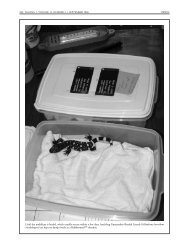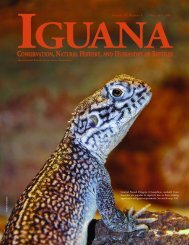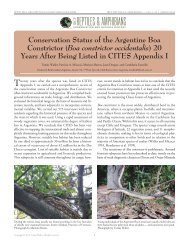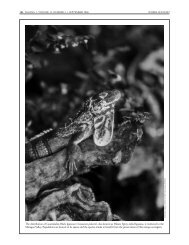Spiny-tailed Iguanas (Ctenosaura similis) in Venezuela
Spiny-tailed Iguanas (Ctenosaura similis) in Venezuela
Spiny-tailed Iguanas (Ctenosaura similis) in Venezuela
Create successful ePaper yourself
Turn your PDF publications into a flip-book with our unique Google optimized e-Paper software.
MICHAEL REDMER DON SHEPARD<br />
178 IGUANA • VOLUME 15, NUMBER 3 • SEPTEMBER 2008 CONSERVATION RESEARCH REPORTS<br />
Road mortality of the endangered Eastern<br />
Massasauga (Sistrurus catenatus) was biased<br />
toward adult males, which show an <strong>in</strong>crease<br />
<strong>in</strong> movement <strong>in</strong> August, co<strong>in</strong>cid<strong>in</strong>g with the<br />
peak of the mat<strong>in</strong>g season and a period of<br />
high tourist visitation.<br />
<strong>in</strong>fluential factors. Carlyle Lake, a popular<br />
tourism/recreation area, is situated <strong>in</strong><br />
a larger agricultural landscape and is<br />
home to the largest Ill<strong>in</strong>ois population of<br />
the endangered Eastern Massasauga<br />
(Sistrurus catenatus). The authors documented<br />
321 cases of reptilian road mortality<br />
(84 <strong>in</strong>dividuals of six turtle species<br />
and 237 <strong>in</strong>dividuals of n<strong>in</strong>e snake<br />
species) while driv<strong>in</strong>g the approx. 46-km<br />
study route roundtrip daily. Turtle road<br />
mortality was highest <strong>in</strong> May and June,<br />
and positively associated with precipitation<br />
and m<strong>in</strong>imum daily temperature.<br />
Colubrid snake road mortality was highest<br />
<strong>in</strong> April and October, and positively<br />
associated with m<strong>in</strong>imum daily temperature.<br />
We recorded 42 cases of road mortality<br />
of S. catenatus, with the highest<br />
number occurr<strong>in</strong>g from mid-August to<br />
mid-September. Road mortality <strong>in</strong> S.<br />
catenatus was biased toward adult males,<br />
which show an <strong>in</strong>crease <strong>in</strong> movement <strong>in</strong><br />
August, co<strong>in</strong>cid<strong>in</strong>g with the peak of the<br />
mat<strong>in</strong>g season and a period of high<br />
tourist visitation. The traffic <strong>in</strong>tensity on<br />
a road segment did not significantly<br />
affect the level of road mortality, but segments<br />
through high-quality habitats had<br />
higher levels of mortality than segments<br />
through lower quality habitats.<br />
Refutation of Traditional Ch<strong>in</strong>ese<br />
Medic<strong>in</strong>e Claims about Turtles<br />
The Ch<strong>in</strong>ese turtle trade is the primary<br />
threat to endangered turtle populations<br />
throughout Asia, primarily because of the<br />
long tradition of consum<strong>in</strong>g turtles <strong>in</strong><br />
Ch<strong>in</strong>a. Practitioners of Traditional<br />
Ch<strong>in</strong>ese Medic<strong>in</strong>e (TCM) promote<br />
nutritional and medic<strong>in</strong>al benefits from<br />
eat<strong>in</strong>g turtles, especially hardshell species.<br />
MEILING ET AL. (2008. Applied<br />
Herpetology 5: 173–187) tested these<br />
claims by determ<strong>in</strong><strong>in</strong>g the nutritional<br />
value of turtle products (meat, fat and<br />
shell) <strong>in</strong> five species of geoemydid turtle,<br />
Cuora trifasciata, C. mouhotii, Mauremys<br />
mutica, M. s<strong>in</strong>ensis, and Geoemyda spengleri.<br />
The authors analyzed nutritional variables<br />
such as the composition of am<strong>in</strong>o<br />
acids, fatty acids, and m<strong>in</strong>eral elements to<br />
determ<strong>in</strong>e the relative nutritional quality<br />
of turtle products. Their study refutes<br />
TCM claims about products made from<br />
hardshell turtles. Alternative animal products<br />
should be substituted to obta<strong>in</strong> similar<br />
m<strong>in</strong>erals, am<strong>in</strong>o acids and fatty acids.<br />
Balanc<strong>in</strong>g the cultural use of turtles with<br />
their conservation status rema<strong>in</strong>s a major<br />
challenge.<br />
Analysis of turtle meat from five species of<br />
Ch<strong>in</strong>ese turtles, <strong>in</strong>clud<strong>in</strong>g Cuora trifasciata,<br />
refuted claims about the nutritional value of<br />
eat<strong>in</strong>g hardshell turtles.<br />
A Sixth Mass Ext<strong>in</strong>ction?<br />
Many scientists argue that we are either<br />
enter<strong>in</strong>g or <strong>in</strong> the midst of the sixth<br />
great mass ext<strong>in</strong>ction. Intense human<br />
pressure, both direct and <strong>in</strong>direct, is hav<strong>in</strong>g<br />
profound effects on natural environments.<br />
The amphibians — frogs, salamanders,<br />
and caecilians — may be the<br />
only major group currently at risk globally.<br />
A de<strong>tailed</strong> worldwide assessment<br />
and subsequent updates show that one-<br />
TORSTEN BLANCK_WIKI.TIF<br />
Amphibian population decl<strong>in</strong>es, extirpations,<br />
and ext<strong>in</strong>ctions may be the first sign of<br />
an impend<strong>in</strong>g mass ext<strong>in</strong>ction. The status of<br />
the critically endangered Mounta<strong>in</strong> Yellowlegged<br />
Frog (Rana muscosa) may be a harb<strong>in</strong>ger<br />
of other decl<strong>in</strong>es <strong>in</strong> the United States.<br />
third or more of the 6,300 species are<br />
threatened with ext<strong>in</strong>ction. This trend is<br />
likely to accelerate because most<br />
amphibians occur <strong>in</strong> the tropics and<br />
have small geographic ranges that make<br />
them susceptible to ext<strong>in</strong>ction. The<br />
<strong>in</strong>creas<strong>in</strong>g pressure from habitat destruction<br />
and climate change is likely to have<br />
major impacts on narrowly adapted and<br />
distributed species. WAKE AND<br />
VREDENBURG (2008. Proceed<strong>in</strong>gs of the<br />
National Academy of Sciences 105:<br />
11466–11473) showed that salamanders<br />
on tropical mounta<strong>in</strong>s are particularly at<br />
risk. A new and significant threat to<br />
amphibians is a virulent, emerg<strong>in</strong>g <strong>in</strong>fectious<br />
disease, chytridiomycosis, which<br />
appears to be globally distributed, and its<br />
effects may be exacerbated by global<br />
warm<strong>in</strong>g. This disease, which is caused<br />
by a fungal pathogen and implicated <strong>in</strong><br />
serious decl<strong>in</strong>es and ext<strong>in</strong>ctions of >200<br />
species of amphibians, poses the greatest<br />
threat to biodiversity of any known disease.<br />
The authors’ data for frogs <strong>in</strong> the<br />
Sierra Nevada of California show that<br />
the fungus is hav<strong>in</strong>g a devastat<strong>in</strong>g<br />
impact on native species, already weakened<br />
by the effects of pollution and<br />
<strong>in</strong>troduced predators. A general message<br />
from amphibians is that we may have little<br />
time to stave off a potential mass<br />
ext<strong>in</strong>ction.<br />
JEFF LEMM








